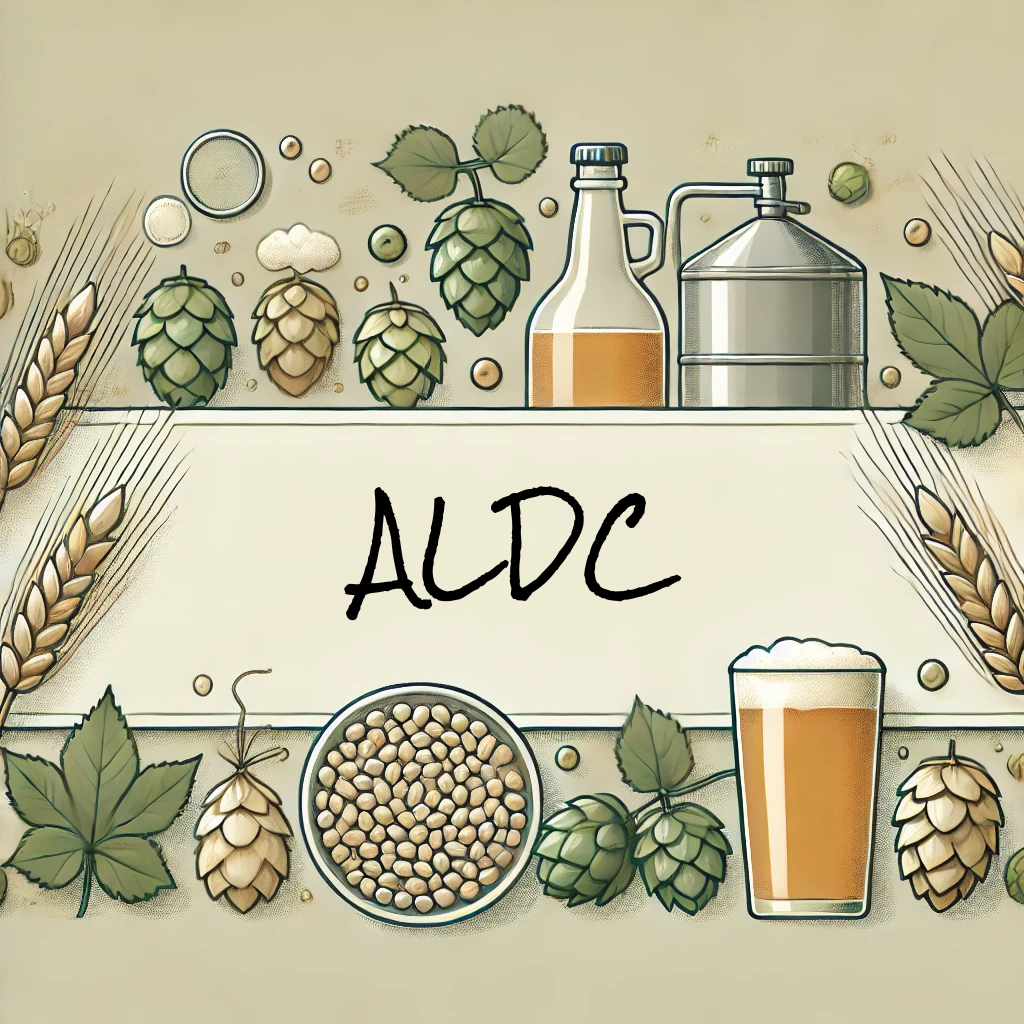
ALDC(α-アセト乳酸デカルボキシラーゼ)の秘密を解き明かす
ALDCとは?
ALDC(α-アセト乳酸デカルボキシラーゼ)は、ビール醸造に革命をもたらす強力な酵素で、一般的な課題であるジアセチルの問題を解決します。バターやバタースコッチに似た風味で知られるジアセチルは、ほとんどのビールスタイルではオフフレーバーと見なされます。ALDCを使用することで、ジアセチルを最小限に抑え、高品質なビールを生産することが可能になります。
醸造におけるALDCの役割
発酵中、酵母はアミノ酸代謝の副産物としてα-アセト乳酸を生成します。この化合物は酸化し、時間とともにジアセチルへと変化します。ここでALDCが重要な役割を果たします:
直接変換:
ALDCはα-アセト乳酸を直接アセトインに変換し、ジアセチルが形成される中間ステップをスキップします。風味の中立性:
アセトインは風味に影響を与えず、ビールが意図した味わいを保ちます。
ALDCの利点
ジアセチル休止時間の短縮:
通常、醸造家は発酵温度を上げてジアセチルを再吸収させるために休止時間を設けます。ALDCはこのステップを最小限に抑え、貴重な時間を節約します。風味の一貫性向上:
ジアセチルの形成を防ぐことで、バッチごとにクリーンで予測可能なフレーバープロファイルを保証します。生産効率の向上:
ターンアラウンドタイムの短縮により、より多くのビールをより短期間で生産できます。高比重ビールに最適:
ALDCは高比重ビールで特に有効で、発酵副産物の増加によるジアセチルのリスクを軽減します。
ALDCの使用方法
ALDCは通常、発酵の開始時に添加されます。正確な投与量はビアスタイルやバッチサイズによりますが、一般的なガイドラインは以下の通りです:
- 投与量: バッチあたり5-10ppm(100万分の1)。
- タイミング: 酵母と一緒に直接発酵槽に投入します。
ALDCが効果的なビアスタイル
ALDCはどのビアスタイルにも使用できますが、特に以下で効果的です:
- ラガー: クリーンなプロファイルのため、ジアセチルが目立ちやすい。
- ピルスナー: クリスプで欠陥のない仕上がりが求められる。
- 高比重エール: 発酵副産物が増加するためジアセチルのリスクが高い。
- ヘビードライホップビール: ドライホッピングは、ホップの酵素活性による二次発酵(いわゆる ホップクリープ )を引き起こすことがあります。このプロセスによりジアセチルのレベルが上昇する可能性がありますが、ALDCを使用することでホップクリープ中のジアセチル形成を防ぎ、IPAやNEIPAなどのホップフォワードなスタイルにおいてクリーンな仕上がりを実現します。
ALDC使用のヒント
- 投与量のモニタリング: 過剰使用は望ましくない結果を招く可能性があるため、適量を守ります。
- 適切な発酵条件を維持: ALDCはジアセチルを減らしますが、一貫した発酵温度と酵母の健康状態は依然として重要です。
- ベストプラクティスの併用: 最適な結果を得るために、ALDCを計画的な発酵スケジュールと併用します。
まとめ
ALDCは、ジアセチルを最小限に抑え、醸造プロセスを効率化したい醸造家にとって画期的な存在です。クリスプなラガーやロバストな高比重エールを醸造する場合でも、ALDCはクリーンで一貫性のあるビールを保証します
Blog Post: Unlocking the Secrets of ALDC in Brewing
What is ALDC?
ALDC, or α-Acetolactate Decarboxylase , is a powerful enzyme that has revolutionized brewing by tackling a common issue: diacetyl. Known for its buttery or butterscotch-like flavor, diacetyl is considered an off-flavor in most beer styles. ALDC provides brewers with a way to minimize diacetyl and produce clean, high-quality beers.
How ALDC Works in Brewing
During fermentation, yeast produces α-acetolactate as a byproduct of amino acid metabolism. This compound can oxidize and convert into diacetyl over time. Here’s where ALDC shines:
Direct Conversion:
ALDC catalyzes the conversion of α-acetolactate directly into acetoin, skipping the intermediate step where diacetyl would form.Flavor Neutrality:
Acetoin is flavor-neutral, ensuring that the beer retains its intended taste profile.
Benefits of Using ALDC
Reduces Diacetyl Rest Time:
Traditionally, brewers perform a diacetyl rest by raising fermentation temperatures to allow yeast to reabsorb diacetyl. ALDC minimizes or eliminates the need for this step, saving valuable time.Improves Flavor Consistency:
By preventing diacetyl formation, ALDC ensures a clean and predictable flavor profile across batches.Boosts Production Efficiency:
Faster turnaround times mean brewers can produce more beer in less time, increasing overall output.Ideal for High-Gravity Beers:
ALDC is particularly useful in high-gravity brews, where diacetyl levels tend to be more pronounced due to increased metabolic byproducts.
How to Use ALDC
ALDC is typically added at the start of fermentation. The exact dosage depends on the beer style and batch size, but general guidelines include:
- Dosage: 5-10 ppm (parts per million) per batch.
- Timing: Add directly to the fermenter with the yeast.
Styles That Benefit from ALDC
While ALDC can be used in any beer style, it’s particularly effective in:
- Lagers: Clean profiles make diacetyl more noticeable.
- Pilsners: Requires a crisp and flawless finish.
- High-Gravity Ales: Elevated diacetyl risk due to increased fermentation byproducts.
- Heavily Dry-Hopped Beers: Dry-hopping can sometimes lead to hop creep , a secondary fermentation caused by enzymatic activity in the hops, which can increase diacetyl levels. ALDC helps mitigate this by preventing diacetyl formation during hop creep, ensuring a clean finish in hop-forward styles like IPAs and NEIPAs.
Tips for Using ALDC
- Monitor Dosage: Overuse can lead to unintended consequences or impact enzyme effectiveness.
- Maintain Proper Fermentation Conditions: While ALDC reduces diacetyl, consistent fermentation temperature and yeast health are still critical.
- Combine with Best Practices: Use ALDC alongside a well-planned fermentation schedule for optimal results.
The Bottom Line
ALDC is a game-changer for brewers seeking to minimize diacetyl and streamline their brewing process. Whether you’re brewing a crisp lager or a robust high-gravity ale, ALDC ensures your beer is clean, consistent, and true to style.
